 Lower Saranac Lake Caretaker's Cabin, when Jay Vandenberg, Jr., was the ranger, 1944 and 1945. Adirondack Daily Enterprise, July 1, 2006
Lower Saranac Lake Caretaker's Cabin, when Jay Vandenberg, Jr., was the ranger, 1944 and 1945. Adirondack Daily Enterprise, July 1, 2006  Tent platform permit #1197, opposite Pope Island, issued to John W. Gorgas in the 1940s. It was one of the last tent platforms to be taken down on Lower Saranac Lake, destroyed over Memorial Day weekend, 1977.
Tent platform permit #1197, opposite Pope Island, issued to John W. Gorgas in the 1940s. It was one of the last tent platforms to be taken down on Lower Saranac Lake, destroyed over Memorial Day weekend, 1977. 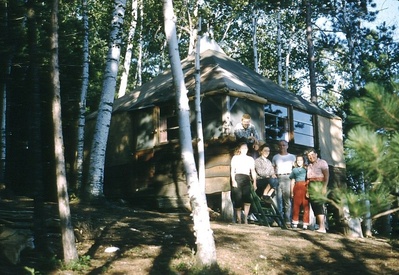 This tent platform was built by the John Atwood family on the northeast shore of Middle Saranac Lake near the present campsite #65. Courtesy of Chris Gorgas.
This tent platform was built by the John Atwood family on the northeast shore of Middle Saranac Lake near the present campsite #65. Courtesy of Chris Gorgas. 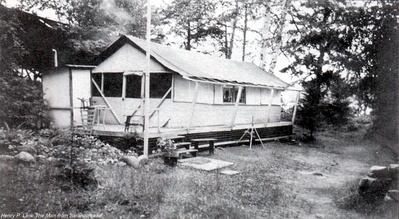 A platform tent at Crescent Bay that was used by the Henry P. Leis family in 1939. Marie Leis Pearce wrote "In later years we also had a State Camp site which we fixed up out on the point by Crescent Bay up at the Lower Saranac Lake. Our numerous visitors could not believe how comfortably and efficiently dad and mom fixed this up. Mom had her kerosene stove; dad put in a sink and chemical toilet. We had lanterns with mantels which gave a great light. Dad filled in the space around the bottom of the platform with a green lattice which was very pretty. He also put windows in the sides supporting the tent and filled in the corners with more latticing. There were roll-up curtains which we could lower when it rained. Mom had flowers in pots and on trellis's around the outside. We entertained ourselves at night sitting around playing cards, which dad loved. When we were down in the village, he would often have his old "cronies" in for the evening. They usually played pinochle or euchre. Here he had to play with us. We also used to sing old and new songs. Lee played the guitar well and used to accompany us. One of my father's favorite songs at this time was "Don't Sit Under the Apple Tree with Anyone Else but Me."
A platform tent at Crescent Bay that was used by the Henry P. Leis family in 1939. Marie Leis Pearce wrote "In later years we also had a State Camp site which we fixed up out on the point by Crescent Bay up at the Lower Saranac Lake. Our numerous visitors could not believe how comfortably and efficiently dad and mom fixed this up. Mom had her kerosene stove; dad put in a sink and chemical toilet. We had lanterns with mantels which gave a great light. Dad filled in the space around the bottom of the platform with a green lattice which was very pretty. He also put windows in the sides supporting the tent and filled in the corners with more latticing. There were roll-up curtains which we could lower when it rained. Mom had flowers in pots and on trellis's around the outside. We entertained ourselves at night sitting around playing cards, which dad loved. When we were down in the village, he would often have his old "cronies" in for the evening. They usually played pinochle or euchre. Here he had to play with us. We also used to sing old and new songs. Lee played the guitar well and used to accompany us. One of my father's favorite songs at this time was "Don't Sit Under the Apple Tree with Anyone Else but Me."  Platform Tent Blueprints, Shown at History Day 2008. Click on the image to enlarge the display
Platform Tent Blueprints, Shown at History Day 2008. Click on the image to enlarge the display  Tent Platforms Display by Amy Catania and Mary Hotaling, Shown at History Day 2008. Click on the image to enlarge the display
Tent Platforms Display by Amy Catania and Mary Hotaling, Shown at History Day 2008. Click on the image to enlarge the display 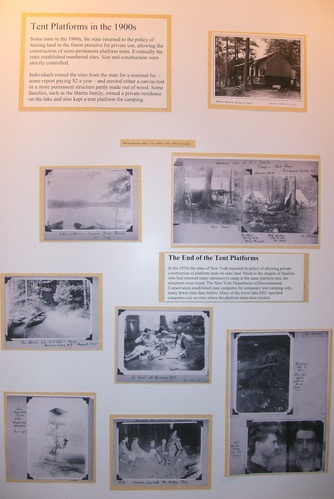 Tent Platforms Display by Amy Catania and Mary Hotaling, Shown at History Day 2008. Click on the image to enlarge the display Before they were banned by the state in 1975 there were some five hundred Platform Tent sites on lakes and ponds in the Saranac Lake area, leased to anyone who applied, for a dollar or two a year.
Tent Platforms Display by Amy Catania and Mary Hotaling, Shown at History Day 2008. Click on the image to enlarge the display Before they were banned by the state in 1975 there were some five hundred Platform Tent sites on lakes and ponds in the Saranac Lake area, leased to anyone who applied, for a dollar or two a year.
The First Private Camps On State Land
Local historian John J. Duquette described the critical moment when private camps were legally established on state land:
“In 1893… Governor Roswell P. Flower (for whom Lake Flower was named) signed a bill authorizing the Forest Commission to sell mature standing timber from within the Park bound. This quite naturally, created quite a furor among those who had been working for more protection. Another privilege assigned to the commission was the granting of camp leases in the Forest Preserve and this, too, was a thorn in the sides of the preservationists. Under Adirondack Park, Article VIII, Section 121, the commissioners were authorized ‘to lease from time to time for a term not longer than five years, land within the Forest Preserve, not more than five acres in one parcel to any person, for the erection of camps or cottages for the use and accommodation of campers.’ Of interest locally, three of such leases were established on Lower Saranac Lake.” 1
The End of the First Era
It was not long before the state changed course and rescinded the law allowing for building on state land. In 1904, The Plattsburgh Republican reported that “three more summer residences built on State lands were destroyed this week by order of the Forest Commission, including the beautiful summer home of Edward Manierre, a Chicago broker, and Miss Myrtle Ayers camp at Saranac lake which was valued at $1,000. This wholesale and wanton destruction of camps built on State lands, with the consent of the State, will undoubtedly be a severe blow to the Adirondacks.” 2
Tent Platforms in the 1900s
Some time in the 1900s, the state returned to the policy of leasing land in the forest preserve for private use, allowing the construction of semi-permanent platform tents. Eventually the state established numbered sites. Size and construction were strictly controlled. Individuals rented the sites from the state for a nominal fee – some report paying $2 a year – and erected either a canvas tent or a more permanent structure partly made out of wood. Some families, such as the Harris family, owned a private residence on the lake and also kept a tent platform for camping.
The End of the Tent Platforms
In the 1970s the state of New York repealed its policy of allowing private construction of platform tents on state land. Much to the chagrin of families who had returned many summers to camp at the same platform tent, the structures were razed. The New York Department of Environmental Conservation established state campsites for temporary tent camping only, many fewer sites than before. Many of the lower lake DEC operated campsites rest on sites where the platform tents once existed.
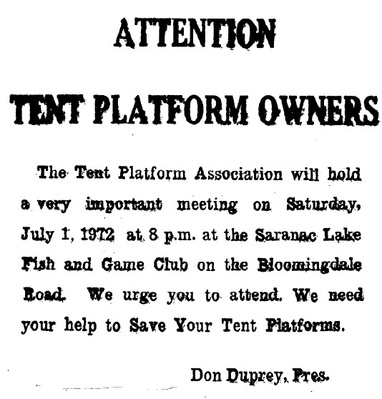 Adirondack Daily Enterprise, June 30, 1972
Adirondack Daily Enterprise, June 30, 1972
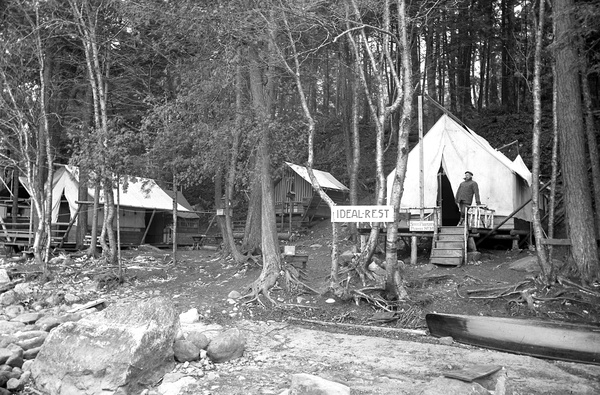 A camp on Lower Saranac Lake, 1926
A camp on Lower Saranac Lake, 1926
New York State Archives, NYSA_14297-87_1493
Adirondack Daily Enterprise, September 10, 1971
Battle Looms Over Controversial Tent Platform Issue
Tent platform permit-holders facing exclusion from state forest lands in a phase-out program included in the zoning concept of Adirondack Park use are banding together in at last ditch effort to keep their privileges.
Thirty hard-nosed campers banded together last night at the Saranac Lake Fish and Game Club and formed the Tent Platform Association. The name was suggested by Dr. Donald Richter who has a camp on Long Pond and Lower Saranac Lake.
The original 30, headed by temporary chairman Donald Dupree was then asked to contact every camp permit holder in this region, a number somewhere in the neighborhood of 600.
Paradoxically almost two thirds of the 600 tent platforms are on Lower Saranac Lake which has become one of the most popular and utilized lakes in the Adirondacks because of the camps and accompanying sociability of the summer season.
The chairman named various contact men to alert as many permit holders as possible to attend a special meeting next Thursday at the Fish and Game Club. Attorney Thomas Cantwell will be asked to attend to explain what steps can be inaugurated in a legal sense to forestall the state's edict.
The informal group, obviously "up in arms" offered several good suggestions regarding the situation facing them in the immediate future. The suggestions will be compiled and forwarded to the Adirondack Park Agency in letter form.
Everyone agreed that if the laws relating to state tent platform were strictly enforced there would be a turnover in campsites which would end the present discriminatory policy.
People simply cannot understand why one person is enjoying a tent platform but another cannot have the same privilege and the state is having a difficult time explaining the situation also.
The state contends that it was "a mistake" to begin with when they allowed tent platforms to be constructed back in the earlier part of the century.
It was a happy mistake for many who have made summer homes of the canvas covered frameworks built to state specifications and a few, permit holders have expanded their "holdings" to include several steeping tents and a kitchen tent all on one location.
It generally entailed a cost of about $1000 to build and equip a camp. The dock was an added expense as was the outhouse. Canvas costing between $100 and $200 had to be replaced from time to time.
The camps were subject to seasonal inspections by state rangers and when abuses were apparent, permit holder was notified w» conform to the code or his permit privilege would be terminated.
Nearly all the campers present last night were willing to pay $100 annually to the state of New York for continuance of the present system.
Also suggested was having the state take over the camps now existing and to lease them back to the public at a set rate for a prescribed time.
The group also felt that many things on the plus side are never brought to the state's attention. The camp Platform permit holders are in effect "watchdogs" and in many cases have prevented forest fires from spreading. They have aided in lost persons searches and their camps have become wilderness headquarters in drownings and other tragedies far off the beaten path.
Also brought out was the fact that campers of the transient type are very careless about their garbage and refuse and when they move on it is left to someone else to clean up after them. Often it is the platform camper who can't stand the smell and unsightliness of the transient's castoffs, who is a clean-up man.
One of the major factors to be considered in this area is the economic impact of losing the summer camping population which amounts to thousands of dollars annually to stores and services which cater to the outdoorsman and his family in necessary staples and sporting equipment.
The Village of Saranac Lake went on record at a recent board meeting as favoring the tent platform concept.
The contact men who have been asked to alert various pond permit holders to the move getting under way are Elwin Hall for Little Green Pond, Randy Bishop and Hugh McLaughlin for Long Pond, Tom Norman Jr., and Mrs. Norman for Follensby Clear Pond, John Wojcic, John Moore and Dr. Donald Richter for Lower Saranac Lake, Elda Kibben for the river, Fred Gladd for Hoel Pond and Bob Stephenson and Ray McCasland for Moose Pond.
It is expected that the September 16th meeting will be one of the largest of its kind since the battle of the platforms began several years back over the Meacham Lake situation.
Essex County Republican, September 8, 1916
COMMISSION GRANTS CAMP PRIVILEGES
One Hundred and Twenty Permits For Erection of Tent Platforms Have Already Been Taken Out.
Permits for the construction of seven open camps in the forest preserve have just been granted by the Conservation Commission to Adirondack guides and residents as a result of the recent extension by Commissioner George D. Pratt of camping privileges upon state land. Under the old regulations only four open camps in all were constructed during a period of three years. Already one hundred and twenty permits for the erection of tent platforms have keen granted this season, and far greater use of the forest preserve than ever before is indicated by the number of applications for them received daily by the Commission…
Henry H. Blagden of Upper Saranac will build two camps, one on Fish Pond and the other on Big Square Pond in Franklin County...
Adirondack Daily Enterprise, March 28, 1972
Tent Platform Holders Present Case
RAY BROOK — With an eloquent presentation bolstered by letters, witnesses and documentary evidence, the case for the New York State tent platform was laid before the Adirondack Park Agency yesterday.
The two hour meeting at Ray Brook Conservation Headquarters attended by 100 staunch supporters was unmarked by outbursts or emotional upsets and a feeling of accord was obvious throughout the lengthy session.
The Agency chairman, Richard Lawrence, told the group that the State Land Plan was due on the Governor's desk June 1 and that little time was left to handle the major problems facing the agency.
Attorney Thomas B. Cantwell attended the late afternoon hearing with remarks for the permit holders giving the essence of their appeal based on 75 years of legal tent camping.
He said that former Conservation Commissioner Harold Wilm stated it correctly when he said that the state had an obligation to Adirondack citizens because New York had taken millions of acres of playground of the economically strapped native population and turned it into a preserve which eventually became known in this area as "The Land of Mustn't Touch" and "Never Never Land."
The tent platform privileges instituted in the late 1890's have come under fire by the. State of New York and are gradually being phased out in one manner or another. There are believed to be 588 legal platforms left in the state at present.
Tent Platform Assn. President Donald Dupree told the agency that every platform with a probable value of $2500 was an outright gift to the state by the permit holder who has no claim to the land or the building. He compared this figure with the cost to the state of a public campsite at Fish Creek which averaged $1800 of the taxpayers dollars spent on each unit.
He told the Agency board that the camper wanted be assessed a fair fee for the privilege and would in turn guarantee to carry out the function of unofficial warden as he always has. The duties imposed upon himself include garbage collector, fire-fighter, tourist guide, first aid station, search coordinator and emergency headquarters official, wildlife protector and provider of an oasis for the injured or stranded.
Bickford Defends Concept
The strongest arguments for continuance of the State platform concept came from former N. Y. State Ranger Jim Bickford. He with Regional Conservation head Bill Petty, had attempted to allow the continued use and expansion of the tent platform sites within certain areas where they were established but also protecting wilderness and river areas where they would destroy the forest appeal.
Former Ranger Bickford who gave 21 years of service to the state said he was against expansion of the platform concept as he believes the saturation point has been reached. He did advocate the continuance of this type camping as it answered a demand not covered by the public campsite provisions.
He said that in his 21 years with the Conservation Department there had never been an instance where the 26 open sites under his jurisdiction had been filled.
He said high prices assessed for tourist activities in the camping field nullified the opportunity for many poor people to come here to enjoy the Adirondack Park. Tent platforms was one answer to the financial pinch suffered by thousands. The ex-ranger cited instances where approximately 60 to 75 fires were prevented from becoming major forest holocausts due to the quick action and unselfish service of the platform owners.
Some blame for campsite abuses was laid at the state doorstep when Carol Yard of the Platform Assn. said that in 10 years he had never seen a state ranger on Hoel Pond. "The field ranks are thin," he said, "and it behooves the owner to do his own policing if he wants anything left."
Several witnesses from outlying points of Franklin County, down state areas and New Jersey were heard briefly and the Park Agency officials said they were delighted to get this in-depth look at the situation since only one of them had ever stayed at a platform camp and that was Mary Prime of Lake Placid.
Adelaide Coyne who compiled volumes of notes and historical data plus letters loaned her files to the Park Agency for study.
The fate of the platform campsite now rests with the vested powers who will make recommendations to the Governor, the Conservation Commissioner and lawmakers.
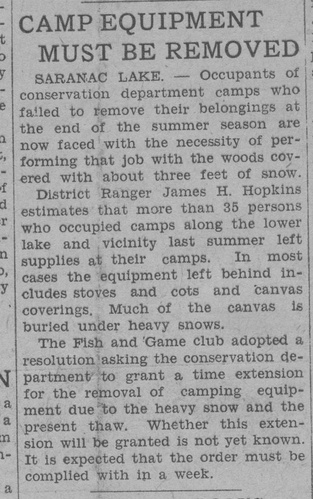 Adirondack Daily Enterprise, May 14, 1975
Adirondack Daily Enterprise, May 14, 1975
Reid signals end for tent platforms
ALBANY — Environmental Conservation Department Commissioner Ogden Reid has decided that tent platform permits definitely will expire on Dec. 31 as previously announced.
Holders of tent platform permits are being advised by letter that permits will not be renewed beyond Dec. 31, and that they should make arrangements to remove all personal property from the platform sites by that time. The department said there are approximately 550 platform permits still in effect, mainly in Essex and Franklin counties. More than half of these are on the shores of Middle and Lower Saranac lakes.
Reid said his major reasons for ending the tent platform system is to conform with the Adirondack Park Agency plan for the use of state land and to provide additional camping space for public use.
He said, "No new permanent tent platform permits have been issued since the mid-1960s when the department began its efforts to phase out uses of the forest preserve that denied full public enjoyment of these highly valued recreation lands. The tent platform permit system represents exclusive private use of public lands, a condition incompatible with the increasing public use of the forest preserve and great demand for transient camping sites"
Adirondack Daily Enterprise, May 14, 1975
Tent platforms-- a requiem
by BILL McLAUGHLIN
The State of New York always maintained that introducing the tent platform concept of camping around 1906 was a serious error of policy and a grievous mistake which had come back to haunt them time after time.
This may be so, but the fact that only 600 or so of the camps were ever in existence must have reduced the headache to a great degree, at least geographically, since all were in or near Saranac Lake.
When the APA decided to eliminate the tent platform as part of their return-to-nature plan the people who have enjoyed their tenuous but highly appreciated grasp of a few hundred square feet of Adirondack wilderness were summarily ordered to evacuate the tent sites by the end of 1975.
The tent platforms had become a symbol to many citizens that even the common man could live next to God and enjoy green forests, blue waters and a campfire to cook his beans on.
Some have held their canvas and 2 x 4 paradises for half a century and have loved even the struggle of maintaining them against storm, heavy snows, rot and predator damage.
The state's constant surveillance of the camp owners was accepted as a necessity of life. The citizen who owned a camp realized that he had become one of the "elite" a few short years back when the issuance of permits to build was severely curtailed.
Camps became a lively topic of constitutional freedoms after the APA had turned thumbs down on their continuance.
The camps had added a positive dimension and were often used as search bases, fire control centers, and various allied purposes when the elements presented unnecessary hardship.
The permit system was well policed for the most part and few aggravated assaults against nature occurred through the existence of the 600 camps, about half of which were on Lower Saranac Lake.
The camps were erected in a manner so that a standard tent could be thrown over the supporting rafters to produce a semi-permanent abode which was both weather tight and roomy.
The interior could be partitioned into bedroom, kitchen and dining area. A small porch about 5 feet deep was included in the plan drawn up by the state and this could be jettisoned to allow more interior room instead.
The permit holders gradually added all the comforts of home. Bottled gas and lights, gas refrigerators, radios and victrolas, boat docks, outdoor recreation area, privy, and sometimes even more tent platforms for sleeping. Most camps had one or two boats.
With the arrival of snowmobiles the camps became usable 12 months of the year. They were always used as hunting and fishing headquarters and their utility mushroomed with the addition of new means and methods of making wilderness acreage accessible.
Some of the "have-nots" were jealous about the situation since they were told that no more camp permits were to be given out. This was gross discrimination at best.
By the end of this year the arguments will all be over and the state will have the headache of knocking down over 500 furnished camps that will be abandoned just as they sit.
See also
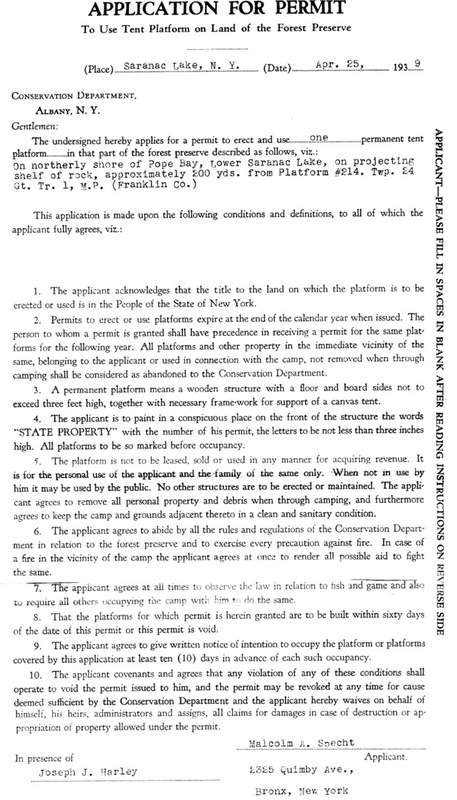 Tent Platform Permit No. 733 application of Malcolm A. Specht, 1939
Tent Platform Permit No. 733 application of Malcolm A. Specht, 1939 
Comments
Footnotes
1. John J. Duquette, “Adirondack commissions, then and now,” Adirondack Daily Enterprise Weekender, 25 May 1991, 2-3. For the original context, see the Annual Report of the Forest Commission for the year 1893, Albany:James B. Lyon, 1894. Full text at Google books
2. Plattsburgh Republican, June 11, 1904.



